Growing Fresh Cabbage in Winter
Craving fresh, homegrown cabbage for your winter meals? You're in luck! This cool-season vegetable thrives in both mild and slightly frosty climates. Not only is cabbage delicious and versatile, but it's surprisingly easy to grow from seed outdoors. In this guide, we'll walk you through the steps for planting and caring for your cabbage, ensuring you harvest healthy, robust heads throughout the colder months.
Read on to learn how to grow cabbage from seeds and transform your garden into a personal cabbage patch!
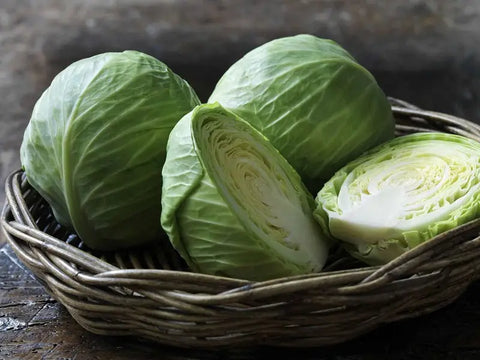
II. How To Grow Cabbage From Seeds Outdoors?
2.2. Preparation
2.3. Sowing Cabbage Seeds
2.4. Caring & Transplanting
4.2. How to store cabbages
I. What's the best cabbage variety to grow?
The "best" cabbage variety depends on several factors, including your climate, desired harvest time, and preferred head size. Here's a breakdown to help you select the perfect variety:
-
Seasonality:
- Late Summer & Fall: Heat-tolerant varieties like Chinese cabbage and red cabbages (Integro, Ruby Perfection, Li Ren Choy) thrive in these seasons.
- Winter: Consider cold-hardy options like Green Boy, Charmant, and OS Cross that can withstand frost. Be aware that winter cabbages often have smaller heads.
- Early Harvest: If speed is key, Stonehead matures in just 67 days, while Primo follows closely at 70-75 days.
- Large Heads: Craving impressive size? Opt for fall-harvesting varieties like Quick Start and Golden Acre.
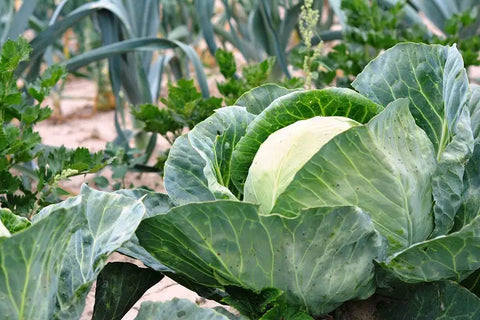
Now that you've chosen your champion cabbage variety, let's move on to learning how to plant cabbage from seeds!
II. How To Grow Cabbage From Seeds Outdoors?
You can directly sow this plant seed outdoors or start the vegetable seed indoors first. But it’s easier and safer to grow it in your garden straightly. Then, you don’t need to prepare too many types of equipment. Let’s check this detailed operation procedure from the best time for growing cabbage from seed outdoors below.
2.1. Time to start seed
The first step is scheduling. You must select the best day to start the seed before transplanting seedlings to the vegetable bed.
- Spring frost crop: You should start seeding 8 to 10 weeks before the last frost.
- Fall crop: You had better sow direct in the garden in midsummer.
Mark the date on your calendar and prepare seeds and equipment for sowing work. Besides, you can watch the weather forecast before starting seeds and sowing. Weather conditions like temperature and rainfall hugely impact the germination rate when growing seeds outdoors.
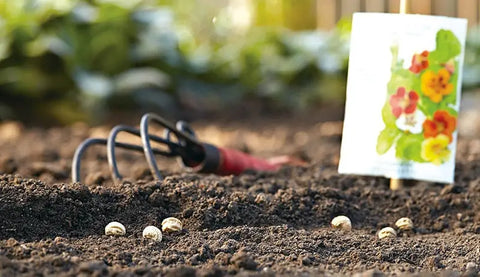
2.2. Soil Preparation
The second step is preparing vegetable seeds, soil beds, PPE, and tools. PPE helps protect your hands when working with soil and fertilizers. Follow these steps to prepare plant seeds and the soil bed in your garden.
- Take dried seeds out of the storage and bag and let them cool down to room temperature. Remove dead and infected seeds.
- Break big soil clumps.
- Remove rocks, debris, dried tree roots, and branches.
- Add fertilizers or composts to fertilize garden soil.
- Level the soil surface.
Soil preparation is a crucial step. Creating a good soil bed to nourish vegetable seeds determines the germination rate. Vegetable seeds need suitable temperature, moisture, and oxygen to sprout perfectly.
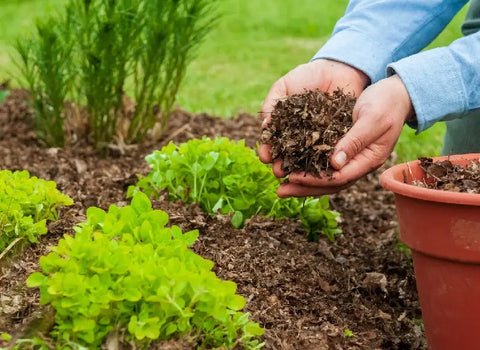
2.3. Sowing Cabbage Seeds
Start to sow cabbage seeds when the soil and vegetable seeds are ready. Sow this greenery seeds outdoors according to the following steps.
- Create a small hole in the soil bed with your finger. It should be 1.3 cm deep. Keep a 25-centimeter space between two holes. Don’t forget to wear PPE gloves.
- Put 2-3 cabbage seeds into the hole.
- Cover a thin layer of soil over the seed.
- Use a watering can to water the soil bed. Keep the soil moist but not sogged.
You can use an irrigation system to water the seed slowly and gradually. Avoid flushing water over the soil and seed. Make sure the soil is still airy to ensure airflow and oxygen supply. Cabbage seeds often sprout at 18 to 24°C.
2.4. Caring & Transplanting
Keep the soil moisture and oxygen rich enough for seeds to germinate. You can cover the vegetable bed to protect plant seeds from heavy rain. Cabbage seeds often sprout after 8 - 14 days. Transplant seedlings when two or three seedlings grow from the same hole.
Only transplant the young plant when it’s 10cm tall and has 4-6 leaves. It often takes the young plant 4 - 6 weeks to be mature enough for transplantation. Maintain the space between vegetables to let them develop heads.
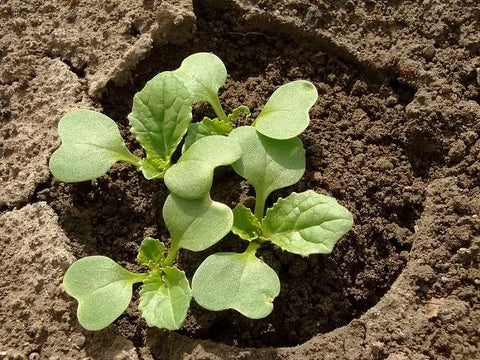
IV. How to Harvest & Store Cabbage
Harvest cabbage heads for cooking when they are mature. How long does it take to grow this vegetable from seed? When can you pick the this greenery head? How long can you store fresh vegetable? Let’s find the answer below to collect and store this vegetable correctly.
4.1. How to harvest cabbage
Typical cabbages are ready to harvest after 2 - 3 months. You should pick up the firm and hearty heads of this vegetable. Push in the green head to check the firmness. Harvest them in the early morning or late afternoon when the temperature is not high. You had better wear thick cotton gardening gloves to avoid cutting your hands.
Follow these steps to cut the cabbage correctly.
- Use a robust and sharp knife to cut the greenery head.
- Sneak the knife into the bottom of the vegetable head and cut it out of the stalk.
- Leave some large outer leaves to let smaller heads grow from the cutting place of the vegetable root.
You can harvest 3 - 6 smaller and looser heads. These subsequent cabbage heads are not firm and big. But they are fresh and healthy.
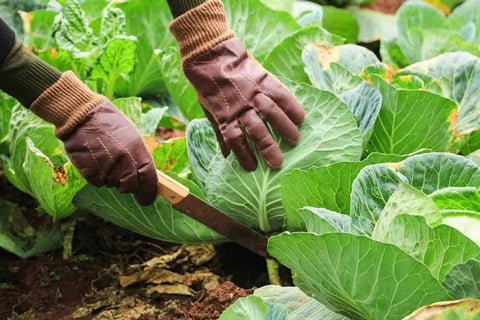
4.2. How to store cabbages
You must store the whole greenery ball to keep them fresh and maintain all its nutrients. Remove loose leaves around the firm vegetable head. Use the food plastic wrapper to cover the green head.
Then, put them in the fridge for no more than one week. Store partially cut cabbages for 3 - 4 days only. Try to use up this green before it gets dehydrated. Keep the temperature between 0 and 4°C to keep them fresh and maintain their nutrients.
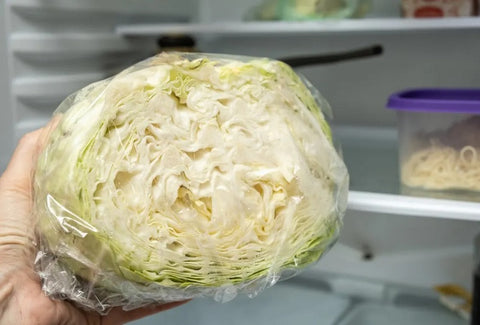
IV. Conclusion
Now that you've explored the wonders of growing cabbage from seeds, you're well on your way to cultivating a bountiful harvest of this versatile cool-season vegetable. Hope that this article was able to help you learn how to grow cabbage from seeds.
Remember, the key is planting at the right time and choosing the cabbage that works best for your climate. With a little patience and by following the tips mentioned in this article, you'll be enjoying the fruits (or should we say, veggies?) of your labor in no time!
FAQs on Growing Cabbage From Seeds
Q1: How long does it take to grow cabbage from seeds?
A: The time it takes to grow cabbage from seeds to harvest typically ranges from 60 to 90 days, depending on the variety you choose.
Q2: Where to buy cabbage seeds?
A: You have several options for acquiring cabbage seeds!
- The Rike: We offer a variety of high-quality cabbage seeds on our website, including classic white cabbage seeds and the ever-popular green bok choi seeds. Our seeds are selected for optimal germination and growth, ensuring a successful harvest!
- Online retailers: Many online retailers offer a wide selection of cabbage seeds. Be sure to choose reputable sellers with good customer reviews.
- Local garden centers: Often carry a variety of vegetable seeds, including cabbage. This can be a convenient option if you want to see the seeds in person before purchasing.
Q3: What are common pests and problems to watch out for when growing cabbage?
A: Cabbage can fall victim to a few common foes. Keep an eye out for:
- Caterpillars: These munchy menaces can wreak havoc on your leaves. Look for signs of damage and handpick them off if you see them.
- Aphids: These tiny sap-suckers can weaken your plants. Try spraying them with insecticidal soap or introducing beneficial insects like ladybugs.
- Clubroot: This fungal disease distorts the roots and stunts growth. Practice crop rotation and avoid planting cabbage in the same spot repeatedly.
Q4: How can I protect cabbage plants from cutworm damage?
A: Cutworms can be a real pain, severing young seedlings at the base. Here are some ways to fight back:
- Collars: Create protective collars from cardboard or plastic cups around the stem of each seedling.
- Diatomaceous earth: Sprinkle this powder around the base of your plants to deter crawling pests.
- Handpicking: Check for cutworms at night and remove them manually.
Q5: What are the nutritional benefits of cabbage?
A: Cabbage is a nutritional powerhouse! It's packed with:
- Vitamin C: Essential for a healthy immune system.
- Vitamin K: Important for blood clotting and bone health.
- Fiber: Aids in digestion and gut health.
- Folate: Crucial for cell growth and development.
Q6: How can I ensure proper growth of cabbage seedlings in terms of light exposure?
A: Seedlings need plenty of sunshine to thrive! Aim for at least 16 hours of light per day. If natural light is limited, consider using grow lights to supplement.
Q7: What is the recommended method for starting cabbage seeds indoors?
A: While not necessary, starting cabbage seeds indoors can give you a head start on the season. Here's a popular method:
- Sow seeds in a seed tray filled with a well-draining potting mix.
- Keep the soil moist but not soggy and provide consistent light.
- Once seedlings have a few true leaves, harden them off before transplanting outdoors.
Q8: What are some popular cuisines that use cabbage?
A: Cabbage is a versatile veggie enjoyed worldwide! Here are a few examples:
- Coleslaw (USA): A classic side dish of shredded cabbage with a creamy dressing.
- Sauerkraut (Germany): Fermented cabbage with a tangy flavor.
- Kimchi (Korea): Spicy pickled cabbage with a complex flavor profile.
- Stuffed Cabbage (Eastern Europe): Cabbage leaves filled with seasoned meat and rice.
Q9: What are some companion plants that go well with cabbage?
A: Companion planting can benefit your cabbage patch! Here are some good neighbors for cabbage:
- Herbs (dill, rosemary): May deter pests with their strong scents.
- Beans: Fix nitrogen in the soil, which benefits cabbage.
- Marigolds: Repel some harmful nematodes.
- Tomatoes: Thought to attract beneficial insects that prey on cabbage pests.





Leave a comment